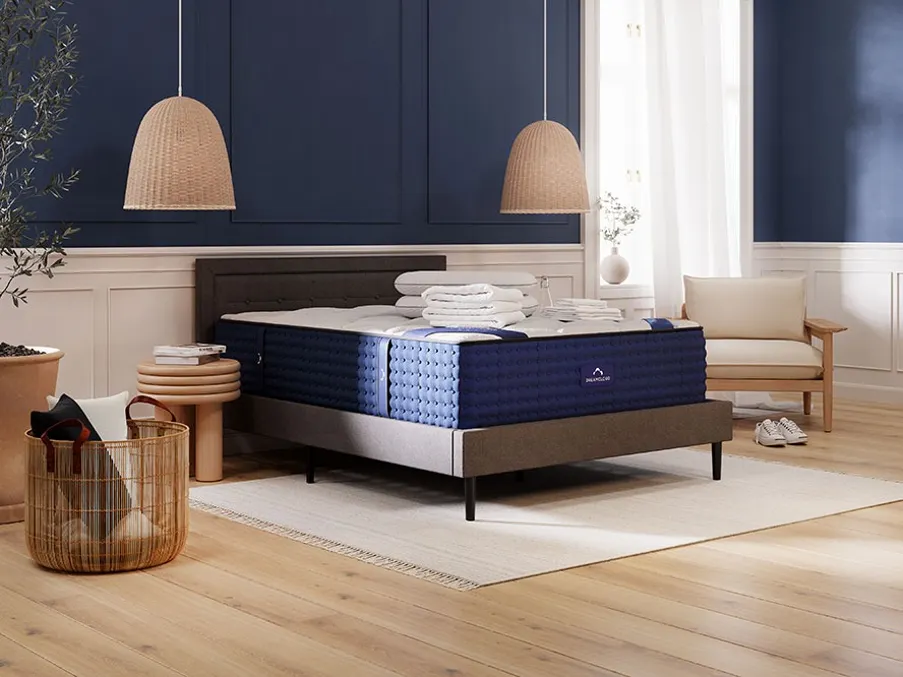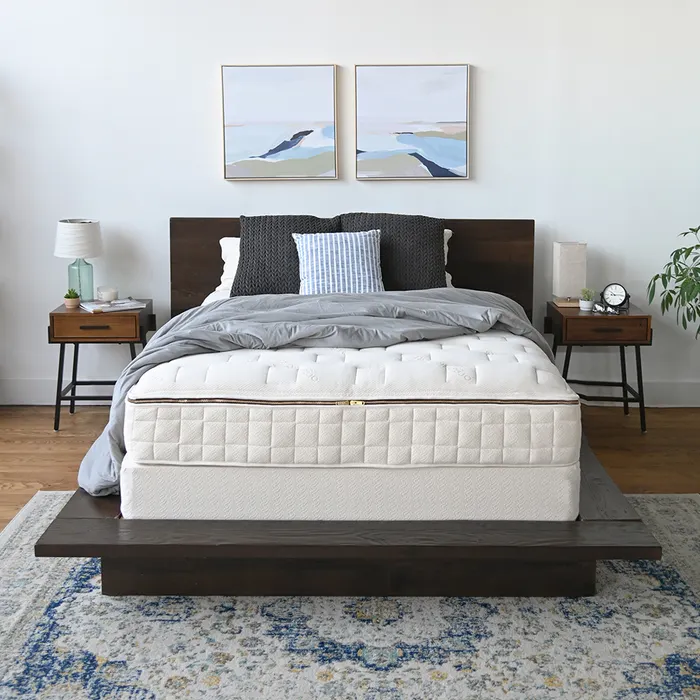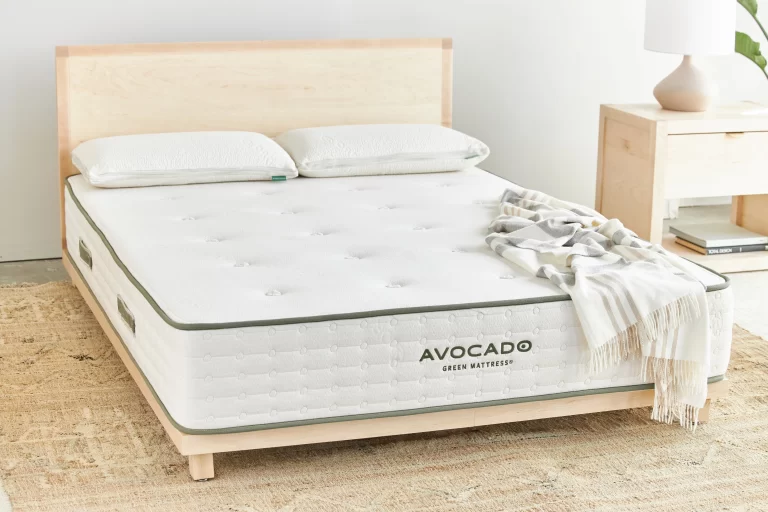Dreamcloud Vs Saatva
When choosing between DreamCloud and Saatva mattresses, you’ll find key differences in construction, comfort, and value. DreamCloud offers a 12-inch hybrid design with a medium-firm feel (6.5-7.5/10) at a lower price point ($1,199 for queen), while Saatva provides three firmness options and superior edge support at a higher cost ($1,595 for queen). Both excel in back support, but Saatva demonstrates better temperature control through its coil-on-coil structure. DreamCloud ships compressed and offers free returns during its 365-night trial, while Saatva includes free white-glove delivery but charges for returns. To make the best choice for your specific sleep needs, consider each mattress’s distinct features and performance details.
>>SAATVA MATTRESS 20% OFF CLICK HERE<<
Construction And Materials
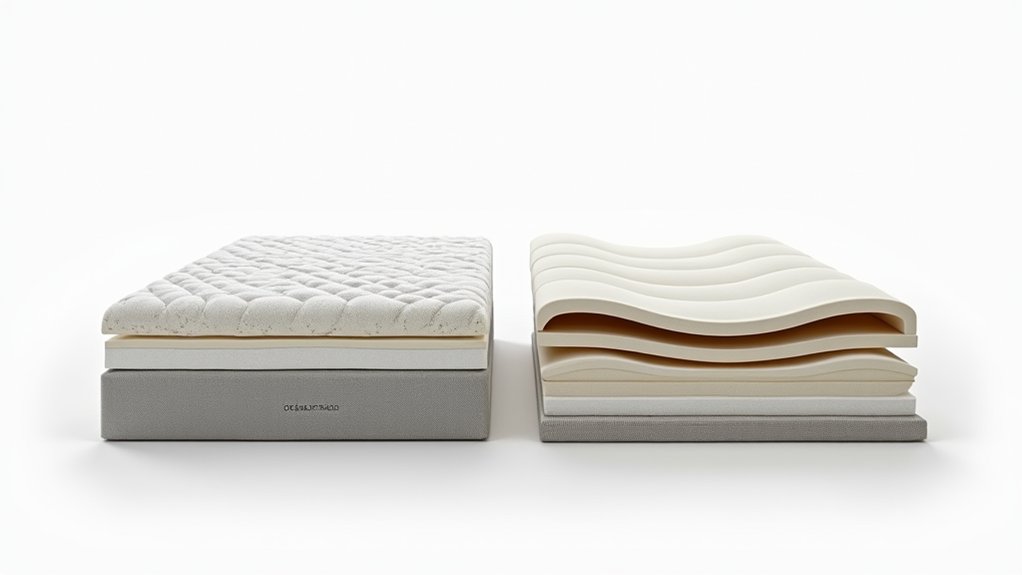
When comparing DreamCloud and Saatva‘s construction, you’ll find notable differences in their approach.
The DreamCloud mattress features a 12-inch profile with multiple specialized layers, starting with a sturdy base of pocketed coils and support foam. Above this foundation, you’ll discover a Dynamic Shift layer with Zoned Support that helps maintain proper spinal alignment. With a firmness rating of 7.1, this construction delivers a medium-firm to firm feel.
The DreamCloud’s comfort system includes dense, viscous memory foam or gel memory foam, topped with a luxurious cashmere blend cover that’s quilted with additional foam. The mattress incorporates cooling gel technology within its memory foam layers to combat heat retention, while the pocketed coils promote airflow throughout the structure.
Edge support is an essential feature in both mattresses, though they tackle it differently. DreamCloud utilizes a heavy-duty gauge edge shield with reinforced springs around the perimeter, resulting in minimal edge sinkage.
While both brands prioritize edge support, independent tests suggest Saatva’s combination of high-density foam rails and reinforced coils may provide slightly better edge stability.
You’ll notice these construction differences most when considering shipping methods – DreamCloud arrives compressed in a box, while Saatva delivers their mattress in its full form.
Comfort Levels And Feel
Beyond their structural differences, DreamCloud and Saatva offer distinct comfort experiences for sleepers. The DreamCloud features a medium-firm to firm feel (6.5-7.5/10) with responsive memory foam that provides a gentle cushioning without excessive sinking. The mattress’s cashmere-blend cover enhances its luxurious comfort experience.
Saatva’s three firmness options give you more flexibility in choosing your ideal comfort level.
When it comes to sleep positions, DreamCloud excels for back and side sleepers, delivering excellent spinal support and pressure relief through its gel-infused memory foam and Dynamic Shift layer.
You’ll find it particularly beneficial if you have achy joints. Saatva’s multiple firmness options accommodate all sleep positions, though front sleepers should avoid the Soft Plush variant.
Both mattresses handle motion transfer differently. DreamCloud’s individually wrapped coils and foam layers effectively minimize movement, making it an excellent choice for couples.
While Saatva’s Firm option provides good motion isolation, the Plush and Luxury Firm versions may transfer more movement.
Edge support is robust in both mattresses, with DreamCloud utilizing thicker perimeter coils and Saatva featuring high-density foam rails.
Temperature Control
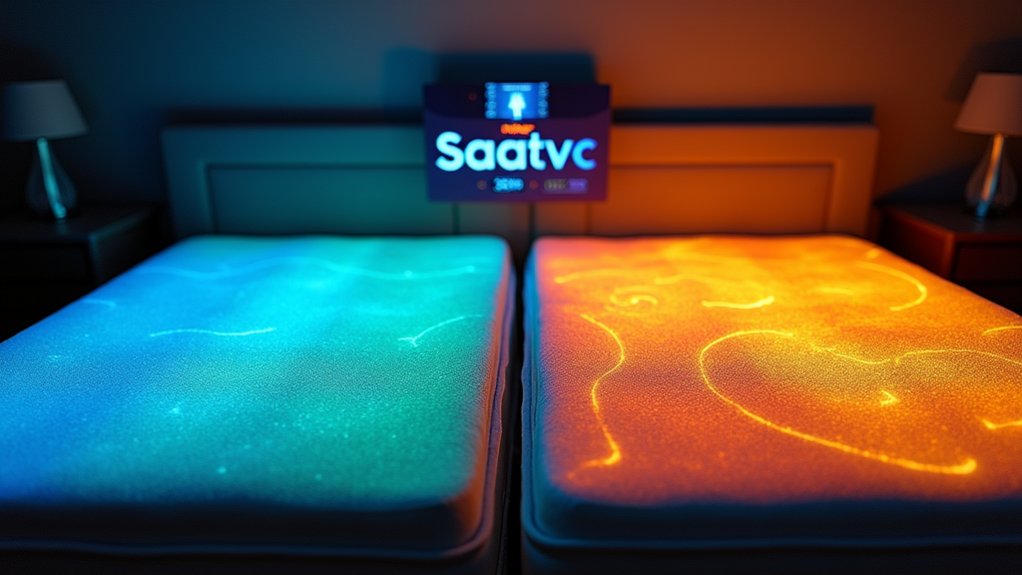
Both mattresses’ temperature regulation stems from their hybrid designs, but they tackle cooling differently.
DreamCloud utilizes gel-infused foam layers and hybrid construction, while Saatva relies on its coil-on-coil structure with minimal foam.
You’ll find that Saatva demonstrates superior overall cooling performance due to its enhanced breathability and efficient heat dissipation.
While DreamCloud shows lower maximum temperatures, its thicker foam layers can retain more heat throughout the night.
Saatva’s design, with fewer foam components, allows for better continuous airflow.
If you’re a hot sleeper, you’ll likely prefer Saatva’s approach.
The mattress’s steel coil construction and reduced foam content create a naturally cooler sleeping surface.
DreamCloud’s active cooling features, like gel infusions, work well for moderate temperature regulation but can’t match Saatva’s natural breathability.
Temperature testing reveals that Saatva experiences a 9-degree Fahrenheit increase, while DreamCloud shows slightly lower temperature changes.
However, Saatva’s superior ventilation system helps maintain consistent comfort throughout the night.
The mattress’s ability to dissipate heat quickly makes it particularly effective for those who tend to sleep warm.
The 14-inch thickness of DreamCloud mattresses may contribute to heat retention compared to Saatva’s slimmer profile.
Motion Transfer
Moving from temperature concerns to sleep disturbances, motion transfer can make or break your mattress experience when sharing a bed.
When comparing DreamCloud and Saatva, you’ll find remarkable differences in how they handle movement isolation.
DreamCloud’s standard model, while featuring pocketed coils and foam layers, allows some motion transfer with a score of 9.7 in testing. Specialized sleep science coaches tested each model extensively in lab conditions.
However, if you’re seeking superior motion isolation, you’ll want to take into account the DreamCloud Premier or Premier Rest models, which incorporate additional memory foam layers.
The Premier Rest particularly excels with a minimal motion transfer rate of 2.62 m/s².
In contrast, Saatva mattresses demonstrate higher motion transfer, especially in their coil-based models.
Their Memory Foam Hybrid registers 10.11 m/s² of motion transfer, considerably higher than DreamCloud’s Premier options.
The coil-on-coil construction in Saatva’s Classic model results in more noticeable movement across the surface.
For light sleepers sharing a bed, you’ll find better performance with DreamCloud Premier models.
If you’re a combination sleeper who values responsiveness over motion isolation, the standard DreamCloud might suit your needs better than Saatva’s offerings.
Pricing And Value
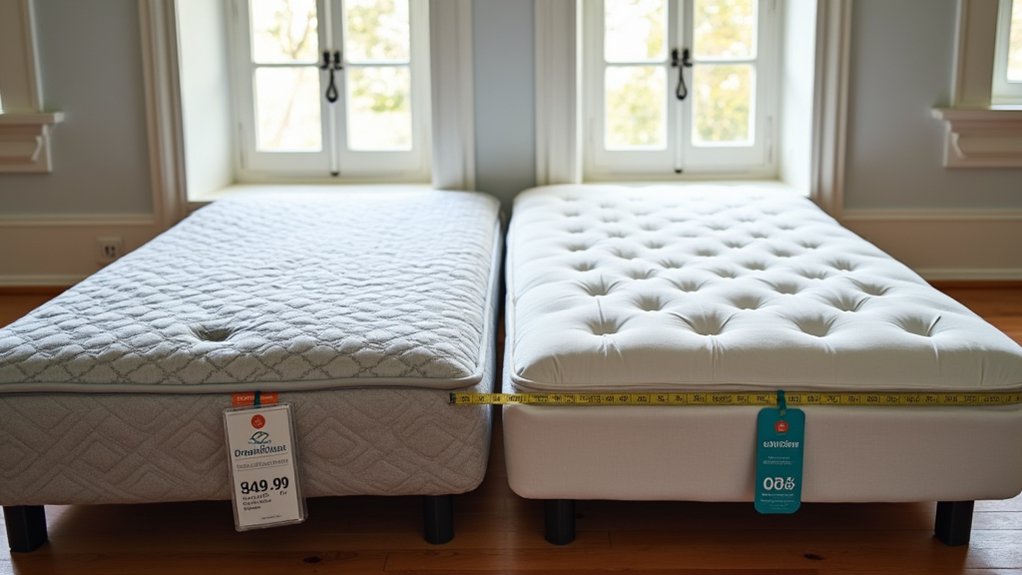
When comparing mattress investments, DreamCloud consistently offers more competitive pricing than Saatva across all sizes. A queen-size DreamCloud Luxury Hybrid retails at $1,199 compared to Saatva Classic’s $1,595, while the price gap widens further with Cal King sizes ($1,399 vs. $1,995). The CertiPUR-US certified materials used in both brands ensure high-quality construction despite the price difference.
You’ll find even more significant savings during DreamCloud’s frequent 50% off promotions, which can reduce a queen mattress to approximately $665. In contrast, Saatva’s discounts typically range from 12-15%, bringing their queen size to around $1,569-$1,624.
The value proposition extends beyond the initial price point. While DreamCloud charges $149 for white glove delivery, Saatva includes this service free but implements a $99 return fee. DreamCloud offers free returns, giving you additional peace of mind with your purchase.
Both brands provide identical trial periods and warranty coverage: a 365-night sleep trial and lifetime warranty.
However, when factoring in the consistent pricing advantages and free returns, DreamCloud emerges as the more cost-effective option without compromising on quality assurances and customer protection.
Customer Experience
The customer experience journey differs markedly between DreamCloud and Saatva, starting with their trial periods and delivery methods.
While DreamCloud offers a generous 365-night trial with free returns, Saatva provides 180 nights but charges a $99 processing fee for returns. Saatva’s complimentary white glove delivery and installation service sets it apart, though you’ll need to evaluate mixed feedback about their contractors.
Reviews indicate that DreamCloud customers experience minimal motion transfer during sleep, making it an excellent choice for couples.
When it comes to customer support, both brands maintain high service standards, but their approaches vary.
You’ll find Saatva’s team particularly helpful with firmness issues, often providing complimentary toppers to enhance comfort. DreamCloud’s support excels in clarity about policies but tends to rely on sharing informational links rather than direct communication.
User satisfaction remains consistently high for both mattresses, with exceptional ratings of 4.8/5 for DreamCloud and 4.9/5 for Saatva.
You’ll notice that customers frequently praise both brands for pain relief and overall comfort, though some users report challenges finding their ideal firmness level.
Both companies demonstrate strong commitment to resolving issues, contributing to their positive reputation in the mattress industry.
Sleep Position Compatibility
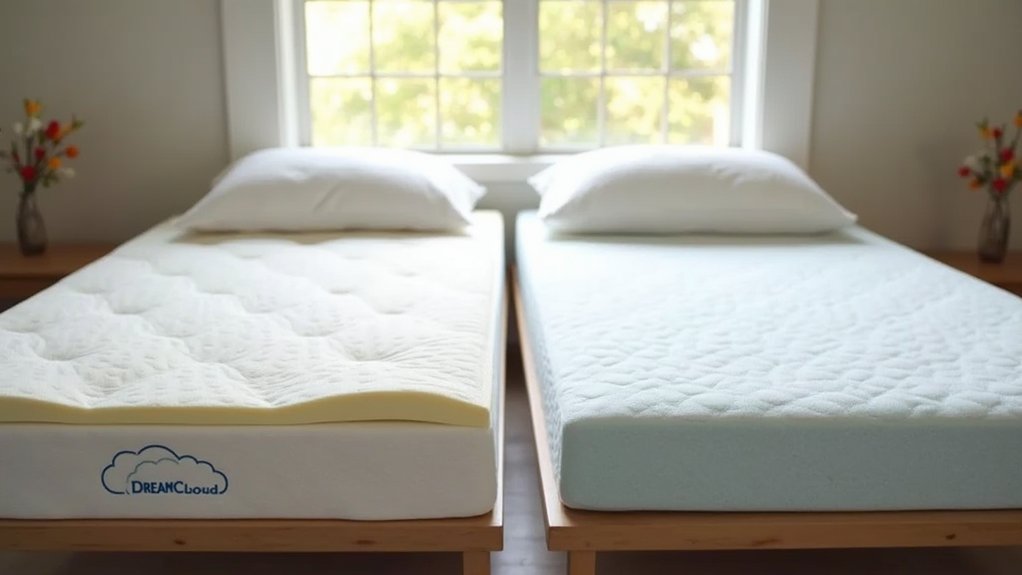
Sleep position preferences play an essential role in choosing between DreamCloud and Saatva mattresses. Both beds excel for back sleepers, with DreamCloud’s targeted lumbar support and Saatva’s ideal firmness levels providing excellent spinal alignment. The DreamCloud’s superior motion isolation makes it an excellent choice for couples who prioritize undisturbed sleep.
If you’re a side sleeper, you’ll likely prefer the Saatva, especially in its Plush version. The DreamCloud’s firmer feel can create unwanted pressure points on your shoulders and hips.
However, if you’re a lightweight side sleeper, you might find the DreamCloud manageable.
Stomach sleepers will appreciate Saatva’s lifted, firm support that prevents hip sinking. While DreamCloud works for lightweight stomach sleepers, those with higher body weight should opt for Saatva to maintain proper sleeping posture.
For combination sleepers, both mattresses offer responsive support through their coil systems.
You’ll find Saatva slightly bouncier, making position changes easier throughout the night. While DreamCloud’s thicker layers provide adequate responsiveness, its softer feel mightn’t match Saatva’s quick adaptability when switching positions.
The key difference lies in versatility: Saatva’s multiple firmness options accommodate more sleep positions effectively, while DreamCloud excels primarily for back sleepers.
Edge Support Performance
Both mattresses excel in edge support, though they achieve it through different mechanisms. The Saatva employs high-density foam rails combined with a reinforced edge support system, while the DreamCloud utilizes a pocketed coil layer with a heavy-duty gauge edge shield. The motion transfer testing shows DreamCloud may have some bounce when sharing the bed.
When it comes to sitting performance, you’ll notice significant differences between the two models. The DreamCloud shows a measured sinkage of 5.0 inches while sitting, which exceeds the recommended 4.0-inch threshold. In contrast, the Saatva demonstrates superior sitting edge support with less than half an inch of compression under weight.
For lying positions, both mattresses perform exceptionally well. You’ll experience consistent support while sleeping near the edges on either mattress, with minimal difference compared to the center. The DreamCloud’s pocketed coils maintain shape effectively, while Saatva’s foam rails guarantee stable edge-to-edge comfort.
If you frequently sit on your mattress’s edge, the Saatva might be your better choice due to its superior sitting edge support. However, if you’re primarily concerned with lying edge support, both mattresses will serve you equally well.
